Normal Read and Write Speed in Task Manager Performance
Many users are slowly migrating from using HDDs to SSDs, the reason is simple – SSDs start upwards a computer rapidly. But irksome SSD read/write speed issues are very much real. If your device contains a Solid-State Bulldoze (SSD), you mayhap noticed that every bit it fills up, its performance falls dramatically. Yous would discover that opening applications and copying files volition take longer than usual, and sometimes this volition also cause freezing issues making your device tougher to use.
SSD is the brusque-form for a solid-state bulldoze; it is a storage device that gained immense popularity in recent times. It adopts integrated circuit assemblies to help people store data for proficient. Nonetheless, several reasons can be responsible for wearisome SSD read or write speed on Windows 10 or other operating systems, these include:
- Low Space
- TRIM command is disabled or doesn't exist
- AHCI mode is disabled
- The Boot sequence is incorrectly configured
- Reckoner or SSD is infected with viruses
- BIOS/firmware is outdated
- Something is incorrect with the SATA port or cable
- Depression RAM.
Among others, these were the almost common reasons for the declination in the speed and performance of the SSD.
TIP: Examination your Read-Write speeds using CrystalDiskMark or Parkdale.
Slow SSD Read or Write Speed on Windows eleven/x
It tin be hard to pinpoint the exact trouble that your system could be facing, nosotros will be listing down some tips that will hopefully get your SSD up and running again.
- Free up space to amend performance
- Brand sure the TRIM command is running
- Enable AHCI mode
- Choose high-performance mode
- Optimize your SSD
- Update Firmware of the SSD
- Configure right Kicking lodge
- Cheque your SATA port
- Check your SATA cable.
Let united states of america look at these solutions in more detail.
1] Gratuitous up infinite to better performance
The less space on your SSD, the slower information technology will perform. If your SSD is at 90 per centum capacity or higher, and you find some performance issues, at this point you should commencement attempt and clear up some space. The virtually obvious thing that you lot can attempt is to starting time deleting unnecessary files and folders from SSD that may be occupying the space.
Another thought that works is to disable hibernation, as this could free up a lot of deejay space for you. Follow these steps:
- Open 'Control Prompt' from 'Windows Search'.
- Type 'cmd'
- Right-click on the top search result and cull control prompt with administrative rights i.east., select the choice 'Run as ambassador'
- Type 'powercfg -h off'
- Hit 'Enter'
In one case you followed the steps mentioned in a higher place to clear off some space in your SSD. Check if at that place accept been any improvements in the SSD read/write speed. If it didn't work, move on to the next solution.
ii] Make certain the TRIM command is running
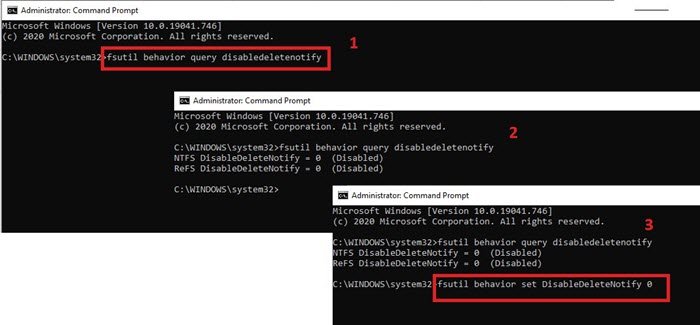
An SSD drive will run dull if the TRIM control is not running. Follow these steps to make sure the TRIM is enabled.
- Click 'Offset' and type 'cmd'
- Right-click 'Control Prompt' and striking 'Open up as Administrator'
- Copy and paste the command – "fsutil behavior query DisableDeleteNotify"
- Press 'Enter'
- Now, if you become '0' as the result, it means TRIM is enabled and if you get '1' it means disabled. Motion on to the next stride if you get '0' in the outcome.
- Blazon fsutil behavior set DisableDeleteNotify 0
- Hit Enter.
This will enable TRIM command on your system.
3] Enable AHCI mode
The Advanced Host Controller Interface (AHCI) specifies the operation of Serial ATA (SATA) host controllers in a not-implementation-specific manner in its motherboard chipsets. The specification describes a system memory structure for estimator hardware vendors to substitution data between host organization retentiveness and attached storage devices. This style is very crucial for y'all to get the best out of the SSD; if information technology's not enabled, your SSD will run slow. You can hands enable AHCI in Windows ten.
4] Choose the Ability high-functioning mode
This is a quick potential fix. Endeavor changing to the Power loftier-operation manner by following the steps below:
1] Search for 'Power & Slumber settings' in the 'Start' carte du jour
2] Scroll downwardly the correct-side options and click on 'Additional ability settings' under 'related settings'
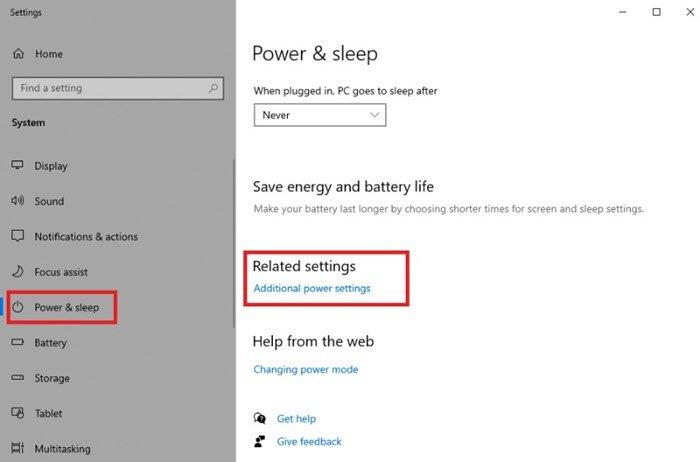
3] In the 'Power Options' window click on 'Create a ability plan' actualization on the left-side menu
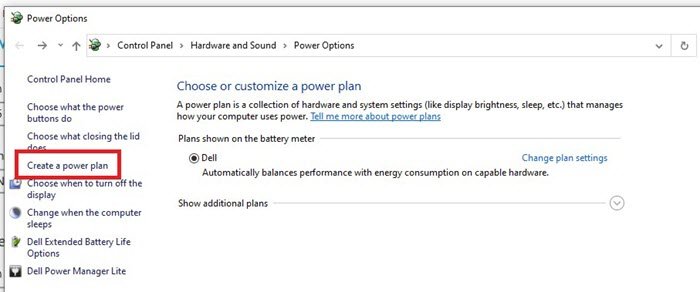
four] Now select 'High Functioning' and click 'Next'
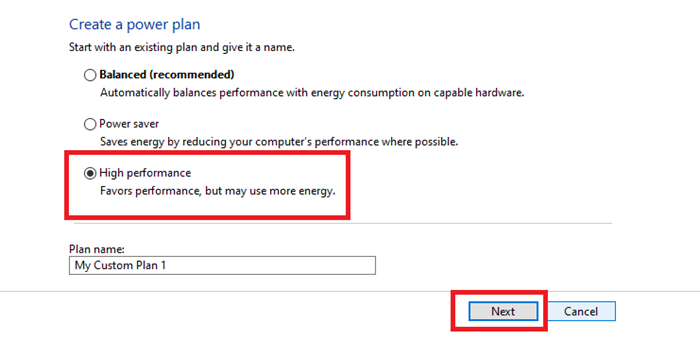
In Balanced Ability Programme, your SSD doesn't receive the total power information technology needs to run at its all-time chapters, on the other mitt, the High-performance programme favors performance.
Read: Do you need to defrag SSD?
5] Optimize your SSD
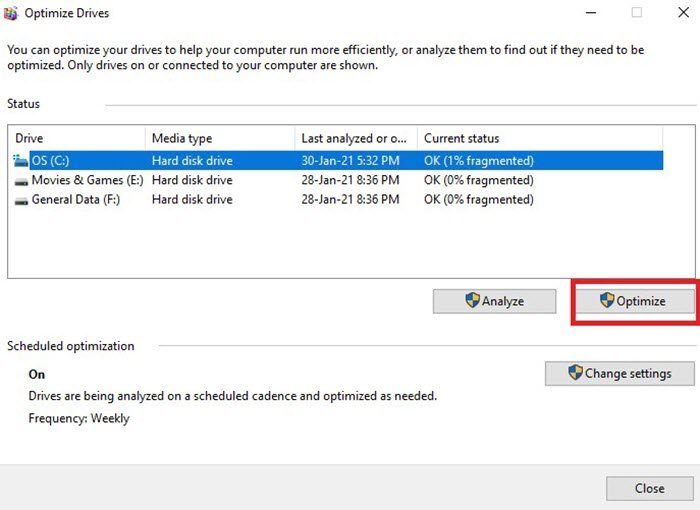
After some time of using an SSD, especially after installing many applications, information technology is recommended to optimize SSD. Follow these steps:
- Search for 'Defrag' in the 'Start menu'
- Select Defragment and Optimize Drive
- Select the SSD drive and click 'Optimize'
Optimizing information technology from time to time helps bring information technology back to its original state.
Read: Optimize and speed up your SSD drive using Tweak-SSD.
6] Update Firmware of the SSD
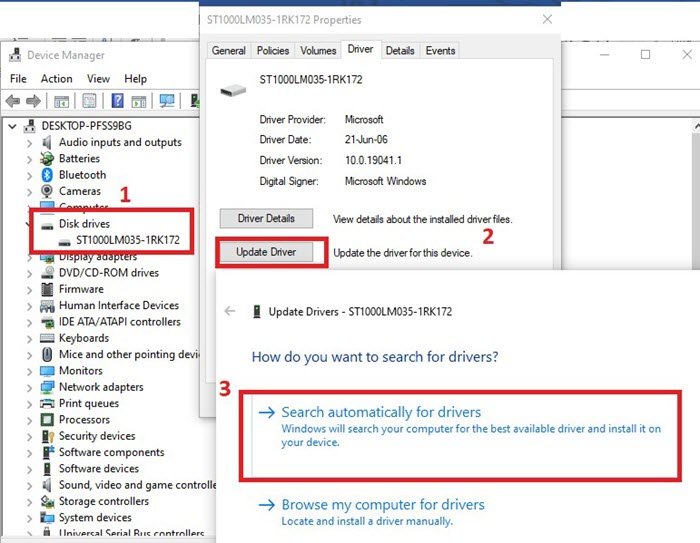
But like other hardware, SSD manufacturers release patches and updates periodically for SSDs too. The firmware of SSDs is essential for running them smoothly and efficiently, and then remember to keep checking for a firmware update. To update your SSD, follow these steps:
- Press 'Win + R' keys to open the 'Run' dialog box.
- In the 'Run' dialog, type 'devmgmt.msc'
- Hitting 'Enter'
- In the 'Device Manager' windows locate 'Disk drives' and click on the arrow and expand it.
- Right-click on the SSD and click 'Update Drivers'
- You will be prompted for options on 'How practise you want to search for drivers?' Click on 'Search automatically for drivers'.
Windows will now search for whatever new updates available for your SSD and install them. In one case the process is completed. bank check if your event is resolved.
vii] Configure correct Boot order
Another reason an SSD bulldoze is wearisome could be that the kicking sequence is wrongly configured. If the showtime priority is given to the difficult drive, instead of SSD, the computer will run irksome. This Windows guide volition prove how you tin kick into Windows 10 firmware settings (UEFI/BIOS), and change the boot order easily.
viii] Check your SATA port
These days most motherboards comprise SATA 3Gbps/ SATA 6Gbps ports. The speed of the port stands heavily on the SSD's performance. It can exist difficult to place the SATA Port, hence you must refer to the motherboard's transmission to correctly determine it. Typically, motherboards fabricated on Intel chipsets contain an Intel SATA controller. This controller specifically has the highest speed. And then, the kicking device should be connected to this ane but.
9] Check your SATA cable
I more reason contributing to a poor SSD operation is poor quality or defective SATA cable. So, have a bank check to confirm if the country of the cable is fine, also it is advised you purchase a SATA cable only from a well-known manufacturer.
Along with the in a higher place, you lot could try increasing your RAM or take a consummate format of your SSD – these tricks besides help in fixing tiresome SSD read or write speed on Windows 10.
Your SSD can get irksome for diverse reasons, but when that happens act immediately and rescue your data considering the SSD may corrupt at any time and you may lose all your valuable data.
Related read: How to increase Hard Drive speed & improve performance.

Source: https://www.thewindowsclub.com/fix-slow-ssd-read-or-write-speed-on-windows-10
Post a Comment for "Normal Read and Write Speed in Task Manager Performance"